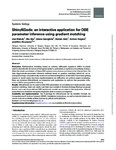ShinyKGode: an interactive application for ODE parameter inference using gradient matching
| dc.contributor.author | Wandy, J | en |
| dc.contributor.author | Niu, M | en |
| dc.contributor.author | Giurghita, D | en |
| dc.contributor.author | Daly, R | en |
| dc.contributor.author | Rogers, S | en |
| dc.contributor.author | Husmeier, D | en |
| dc.date.accessioned | 2021-09-28T09:58:28Z | |
| dc.date.available | 2021-09-28T09:58:28Z | |
| dc.date.issued | 2018-07 | en |
| dc.identifier.issn | 1367-4803 | en |
| dc.identifier.uri | http://hdl.handle.net/10026.1/17958 | |
| dc.description.abstract |
MOTIVATION: Mathematical modelling based on ordinary differential equations (ODEs) is widely used to describe the dynamics of biological systems, particularly in systems and pathway biology. Often the kinetic parameters of these ODE systems are unknown and have to be inferred from the data. Approximate parameter inference methods based on gradient matching (which do not require performing computationally expensive numerical integration of the ODEs) have been getting popular in recent years, but many implementations are difficult to run without expert knowledge. Here, we introduce ShinyKGode, an interactive web application to perform fast parameter inference on ODEs using gradient matching. RESULTS: ShinyKGode can be used to infer ODE parameters on simulated and observed data using gradient matching. Users can easily load their own models in Systems Biology Markup Language format, and a set of pre-defined ODE benchmark models are provided in the application. Inferred parameters are visualized alongside diagnostic plots to assess convergence. AVAILABILITY AND IMPLEMENTATION: The R package for ShinyKGode can be installed through the Comprehensive R Archive Network (CRAN). Installation instructions, as well as tutorial videos and source code are available at https://joewandy.github.io/shinyKGode. SUPPLEMENTARY INFORMATION: Supplementary data are available at Bioinformatics online. | |
| dc.format.extent | 2314 - 2315 | en |
| dc.language | en | en |
| dc.language.iso | en | en |
| dc.publisher | Oxford University Press (OUP) | en |
| dc.title | ShinyKGode: an interactive application for ODE parameter inference using gradient matching | en |
| dc.type | Journal Article | |
| plymouth.issue | 13 | en |
| plymouth.volume | 34 | en |
| plymouth.journal | Bioinformatics | en |
| dc.identifier.doi | 10.1093/bioinformatics/bty089 | en |
| plymouth.organisational-group | /Plymouth | |
| plymouth.organisational-group | /Plymouth/Faculty of Science and Engineering | |
| plymouth.organisational-group | /Plymouth/REF 2021 Researchers by UoA | |
| plymouth.organisational-group | /Plymouth/REF 2021 Researchers by UoA/EXTENDED UoA 10 - Mathematical Sciences | |
| plymouth.organisational-group | /Plymouth/REF 2021 Researchers by UoA/EXTENDED UoA 10 - Mathematical Sciences/UoA 10 - Former and non-independent | |
| plymouth.organisational-group | /Plymouth/REF 2021 Researchers by UoA/UoA10 Mathematical Sciences | |
| dcterms.dateAccepted | 2018-02-26 | en |
| dc.rights.embargodate | 2021-09-29 | en |
| dc.identifier.eissn | 1460-2059 | en |
| dc.rights.embargoperiod | Not known | en |
| rioxxterms.versionofrecord | 10.1093/bioinformatics/bty089 | en |
| rioxxterms.licenseref.uri | http://www.rioxx.net/licenses/all-rights-reserved | en |
| rioxxterms.licenseref.startdate | 2018-07 | en |
| rioxxterms.type | Journal Article/Review | en |


